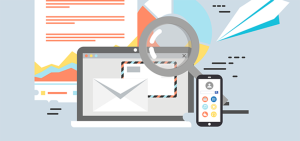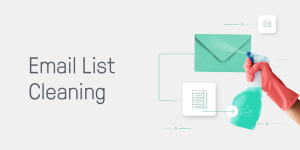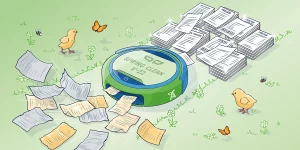Email List Management is the systematic and strategic process for organizing and managing an email list that’s used to support marketing campaigns. The practice involves a careful selection and management of email addresses for individuals or organizations who have chosen to receive communication from an organization or brand.
The Following are the Key Aspects of Email List Management:
Acquisition is the process of adding email addresses and collecting them. You can do this through multiple channels, such as signup forms on websites, online promotional campaigns, and events.
Segmentation: The email list can be divided into segments according to specific criteria, such as the location or behavior of the user. It allows targeted, personalized communications.
Cleaning: Reviewing and updating your email list regularly to maintain accuracy and relevancy. It is important to remove inactive subscribers or those who are not engaged, fix errors, and handle unsubscribes.
Optimizing: Improving the performance of emails through strategic changes. It may be necessary to test different subject lines or content as well as send times to increase open rates.
Compliant: Ensure that email marketing practices are compliant with laws and regulations such as antispam laws. Also, obtain permission before sending out marketing emails.
Analysis: Using metrics and analytics to measure the efficacy of email campaigns. It is important to monitor open rates, conversion rates, and click-through rates to evaluate the effectiveness of your email marketing campaigns.
Why Important to Clean Up Your Email List?
It is important to clean up your list of email addresses. This will help maintain an effective email marketing campaign and increase metrics such as conversions and open rates.
Your business can reap many benefits from a well-curated list of subscribers with valid emails and engaged email addresses.
It is likely to lead to better conversion rates and open rates.
When you clean your email list, you will remove contacts that are unsubscribed or invalid.
This can increase your campaign’s effectiveness and improve your list quality.
Some email cleaning can help you comply with laws and regulations governing email marketing, like the CAN-SPAM Act and GDPR.
The following are some of the main reasons that Cleaning your email list is so important.
Improved Engagement Metrics:
-
- Why It Matters: Engaged Subscribers are more likely than not to read and open your email. A higher engagement rate will positively affect your email marketing results.
- Benefits: Increased engagement metrics such as click-through and open rates contribute to your campaign’s success and build loyal audiences.
How to Avoid Spam Filters:
-
- Why It Matters: Internet service providers use sophisticated algorithms to detect spam. Your deliverability may suffer if your email consistently sets off spam filters.
- Benefits: Cleaning your email list regularly reduces the chances of sending messages to recipients who are inactive, or uninterested. This will minimize the chance of having spam marked against you.
Enhance Brand Reputation
-
- Why It Matters: If you send out irrelevant emails, your subscribers may mistakenly associate your brand with spam.
- Benefits: A clean email list ensures your message will be targeted, and valuable and contribute to the positive perception your brand has among your target audience.
Bounce Rates Increased:
-
- Why It Matters: A high bounce rate can negatively affect your sender score and indicate to ISPs that your email practice may be suspect.
- Benefits: Regular list-cleaning reduces undeliverable email, allowing you to maintain a good sender’s reputation and low bounce rates.
Impact of Sender Score on
-
- Why It Matters: Internet service providers assign scores to senders based on a variety of factors including complaint and engagement rates. Low sender scores can cause email delivery issues.
- Benefits: Cleansing your email list will help you maintain a good sender score. This ensures that your emails get categorized as valid and are placed in the Inbox.
Legal implications:
-
- Why It Matters: Non-compliance with laws and regulations governing data protection, like GDPR, could result in fines and legal penalties.
- Benefits: Cleaning and maintaining your mailing list regularly ensures that you comply with privacy laws, protecting your company from legal trouble.
Email marketing ROI decreases:
-
- Why It Matters: Uninterested or inactive subscribers can reduce the ROI of your email marketing campaigns.
- Benefits: Cleaning up your database will improve the quality of your audience and lead to better campaigns.
How Email Validation Prevents Spam Traps
Validation of emails is a procedure that checks the legitimacy of an email account is legitimate.
It ensures that it is created, is valid as a valid email address, and can send email messages.
Companies need to make sure that their marketing emails are effective and don’t send emails to spam areas.
Spam traps are email addresses used to find people who are spammers.
The most common type is an address for email that has been removed from use however it remains in use.
If a spammer forwards the email address to a trap for spam, it’s a clear sign that the email wasn’t acquired through legitimate methods.
The email checker service providers employ traps for spam to detect spammers and stop their email messages.
The validation of email addresses will stop companies from sending email to spammers.
By validating email addresses before sending out emails, companies can make sure that email marketing campaigns work as well as ensure they don’t forward emails to spammers.
It can also help companies protect their reputations and avoid getting blacklisted by email providers.
How to Clean Email List?
It is important to clean your email list to maintain its health. This will ensure the success of your marketing emails. This is a guide that will show you how to do it.
Identify Inactive Subscribers:
- Metrics analysis: Analyze metrics, such as click-through rate, open rates, and engagement histories, to determine inactive subscribers.
- Create Criteria: Define a set of criteria to identify inactive email subscribers, based on their interaction history with emails.
Use tools for analysis:
- Email Platform Analytics: Use analytics tools offered by your email platform to get insights into subscriber behavior.
- Third-Party Tools: Use third-party tools that are specialized in analyzing email lists to gain a more comprehensive picture.
Segment your list:
- Categorize subscribers: Segment the list by engagement level, demographics, or any other relevant criteria.
- Targeted campaigns: Customize your emails for certain segments to engage subscribers.
Implement Re-engagement Campaigns:
- Target Emails: Create and send emails that are compelling to reactivate inactive subscribers.
- Incentives: Provide incentives such as discounts or exclusive content to increase engagement.
Remove Unengaged Subscribers:
- Remove Criteria: Define criteria to remove subscribers such as an inactivity period.
- Remove unengaged users from your list: Remove subscribers safely to increase engagement.
Correct and Verify Email Addresses :
- Email verification Tools: Check the validity of emails using email verification tools.
- Fix Errors: Remove or update email addresses that have errors to avoid bounces.
Update your preferences:
- Preference Centre: Inspire subscribers to change their preferences by creating a preference center.
- Email Frequency Options: Let subscribers choose the frequency of their emails to help reduce unsubscriptions.
Monitor Bouncing Rates:
- Check bounces regularly: Track bounce rates, and remove emails that bounce frequently.
- Classify Bounces: Distinguish between soft bounces and hard bounces.
Compliance with the Regulations:
- Privacy Regulations Comply with privacy laws such as the GDPR or CAN-SPAM.
- Permission-based marketing: Send emails only to those subscribers who explicitly consent.
Audits Regular:
- Regular Audits: Perform regular audits on your email list.
- Refine Strategies: You can refine your strategies by adjusting them based on these audits. This will help you to improve the health of your list.
Automated cleaning services:
- List Cleaning Services Discover automated list cleaning services to streamline the process.
- Incorporation: Integrate this service with your email platform to ensure seamless operation.
What is the Email Cleaning Process
To ensure that your email marketing campaigns are healthy and effective, you need to take several steps in the email list cleansing process. This is a quick overview.
Data Analyses:
- Metrics Assessment: Start by analyzing key metrics, such as the open rate, click-through rates, and engagement history.
- Find Inactive Subscribers Find criteria for identifying inactive subscribers by analyzing their interaction history.
Segmentation:
- Categorize Subscribers: Segment subscribers based on their engagement level, demographics, or other factors.
- Segmented Campaigns: Create targeted campaigns by segmenting your subscribers.
Re-engagement Campaigns:
- Develop engaging content: Create engaging emails to win back inactive users.
- Offer incentives to subscribers: Use exclusive promotions or offers, as well as incentives to encourage them to return.
Remove Unengaged Subscribers :
- Define Removing Criteria: Establish specific criteria to remove unengaged email subscribers from your list.
- Remove unengaged Subscribers: Safely remove identified subscribers to increase overall engagement rates.
Verify Email Address:
- Verification Tools: Utilize email verification tools to verify the validity and accuracy of emails.
- Correction of Errors: Correct or update email addresses that have errors to improve delivery and prevent bounces.
Preference Centre Updates:
- Promote Updates: Inspire subscribers to make updates through an online preference center.
- Email Frequency Options Let subscribers choose the frequency of their emails to help reduce unsubscriptions.
Monitor Bounce Rates:
- Checking regularly: Monitoring bounce rates to quickly identify issues.
- Distinguish between Bounces. Determine whether a bounce is permanent or temporary.
Compliance with Regulatory Compliance:
- Privacy Regulations Comply with privacy laws such as the GDPR or CAN-SPAM.
- Permission-Based Marketing: Adhere to strict permission-based practices to remain compliant with the law.
Scheduled audits:
- Scheduled Evaluation: Perform scheduled audits to evaluate the health of your list.
- Strategic Alignments: Adjust email marketing strategies following audit results to continuously improve.
Consider Automated Cleansing Services:
- Cleaning Services List: Discover automated cleaning services to streamline your cleaning process.
- Integration: Integrate automatic cleaning services into your email marketing platform to increase efficiency.





